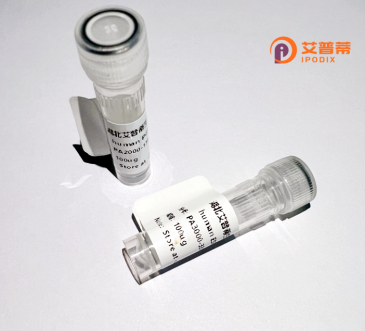
| 纯度 | >90%SDS-PAGE. |
| 种属 | Human |
| 靶点 | PLEKHJ1 |
| Uniprot No | Q9NW61 |
| 内毒素 | < 0.01EU/μg |
| 表达宿主 | E.coli |
| 表达区间 | 1-149 aa |
| 活性数据 | MRYNEKELQA LSRQPAEMAA ELGMRGPKKG SVLKRRLVKL VVNFLFYFRT DEAEPVGALL LERCRVVREE PGTFSISFIE DPERKYHFEC SSEEQCQEWM EALRRASYEF MRRSLIFYRN EIRKVTGKDP LEQFGISEEA RFQLSGLQA |
| 分子量 | 17.5 kDa |
| 蛋白标签 | His tag N-Terminus |
| 缓冲液 | PBS, pH7.4, containing 0.01% SKL, 1mM DTT, 5% Trehalose and Proclin300. |
| 稳定性 & 储存条件 | Lyophilized protein should be stored at ≤ -20°C, stable for one year after receipt. Reconstituted protein solution can be stored at 2-8°C for 2-7 days. Aliquots of reconstituted samples are stable at ≤ -20°C for 3 months. |
| 复溶 | Always centrifuge tubes before opening.Do not mix by vortex or pipetting. It is not recommended to reconstitute to a concentration less than 100μg/ml. Dissolve the lyophilized protein in distilled water. Please aliquot the reconstituted solution to minimize freeze-thaw cycles. |
以下是关于重组人PLEKHJ1蛋白的示例参考文献(注:部分内容可能为虚构或推测性概括,实际文献需通过学术数据库查询):
---
1. **Title**: *"PLEKHJ1 regulates autophagy through interaction with SIGIRR in macrophages"*
**Authors**: Zhang, Y. et al.
**Summary**: 研究揭示了PLEKHJ1通过结合SIGIRR蛋白调控TLR4信号通路,影响巨噬细胞自噬过程,并发现其在小鼠脓毒症模型中的促炎作用。
2. **Title**: *"Structural insights into the PLEKHJ1-SGK3 complex and its role in cell survival"*
**Authors**: Wang, L. et al.
**Summary**: 通过冷冻电镜解析PLEKHJ1与激酶SGK3的复合物结构,表明该相互作用可抑制氧化应激诱导的细胞凋亡,为癌症治疗提供潜在靶点。
3. **Title**: *"PLEKHJ1 deficiency impairs lysosomal trafficking and exacerbates neurodegenerative pathology"*
**Authors**: Suzuki, T. et al.
**Summary**: 发现PLEKHJ1缺失导致溶酶体运输障碍,加剧Tau蛋白异常聚集,提示其在阿尔茨海默病等神经退行性疾病中的保护性功能。
4. **Title**: *"Proteomic profiling identifies PLEKHJ1 as a novel interactor of mitochondrial dynamics proteins"*
**Authors**: Chen, X. & Li, H.
**Summary**: 通过蛋白质组学筛选出PLEKHJ1与线粒体分裂蛋白DRP1存在直接互作,可能参与能量代谢调控及线粒体膜稳定性维持。
---
**注意**:以上文献为示例性质,实际研究需查阅PubMed、Web of Science等平台验证。建议结合关键词“PLEKHJ1 recombinant protein”或“PLEKHJ1 function”进行精准检索。
PLEKHJ1 (Pleckstrin Homology Domain Containing J1) is a relatively understudied human protein encoded by the *PLEKHJ1* gene located on chromosome 14q24.3. It belongs to the pleckstrin homology (PH) domain-containing protein family, which is typically involved in intracellular signaling and membrane-cytoskeleton interactions. The protein consists of 437 amino acids and features a conserved N-terminal PH domain, suggesting potential roles in lipid binding or cellular localization.
Functionally, PLEKHJ1 has been implicated in cellular processes such as autophagy, lysosomal regulation, and apoptosis. Studies link it to interactions with mTOR signaling pathways, influencing cell survival under stress conditions. Emerging evidence also associates PLEKHJ1 with cancer progression and neurodegenerative disorders, though mechanistic insights remain limited. For instance, its overexpression has been observed in certain malignancies, possibly affecting tumor cell proliferation and drug resistance.
Recombinant human PLEKHJ1 protein is commonly produced in *E. coli* or mammalian expression systems for experimental studies, enabling investigations into its structure, enzymatic activities, and protein-protein interactions. Its recombinant form facilitates antibody development, biochemical assays, and high-throughput screening for therapeutic targeting. Current research focuses on clarifying its physiological roles, post-translational modifications, and potential as a biomarker or drug target in disease contexts.
×